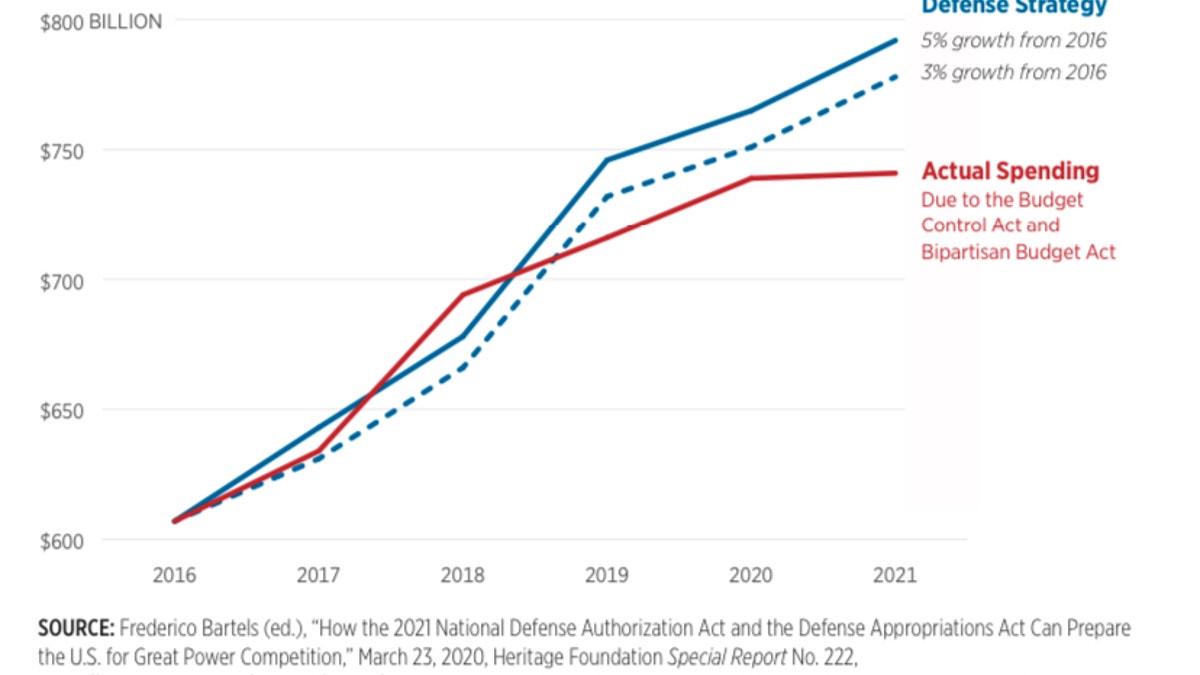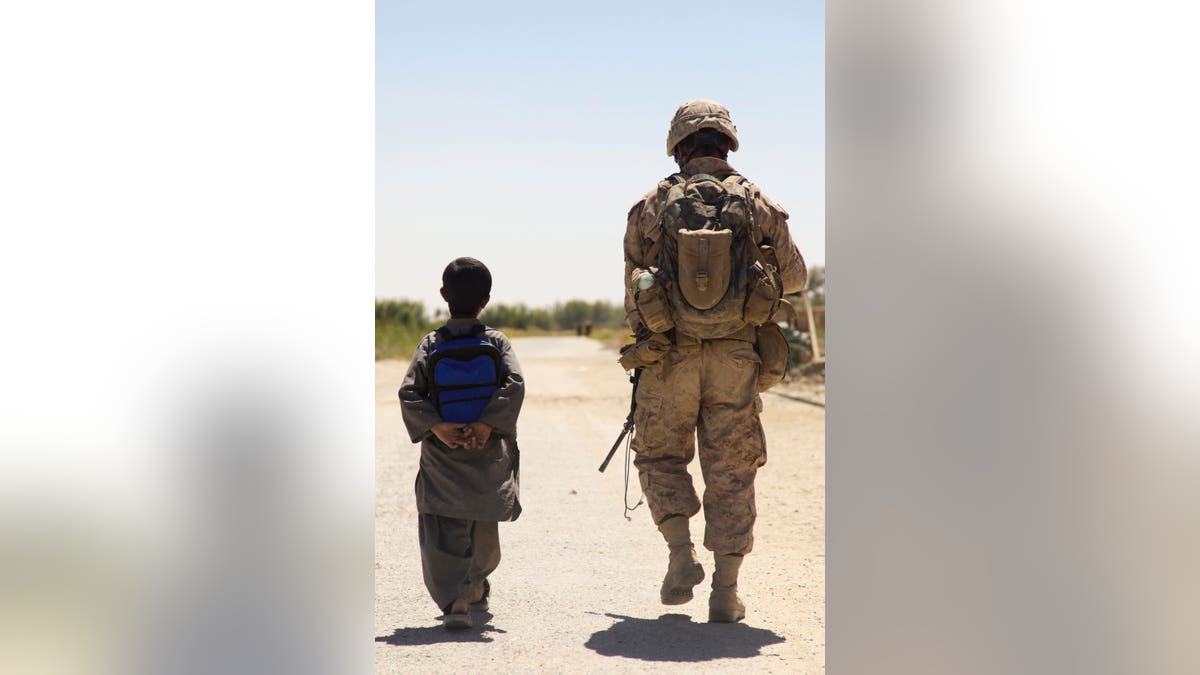Far-left Democrats renew push to make steep cuts to defense budget
Fox News senior strategic analyst Jack Keane argues if defense cuts are made it would be devastating to the military.
The United States military still reigns as the most preeminent one in the world, but a new report exclusively obtained by Fox News shows that sustaining that superiority is far from guaranteed as the Pentagon still trudges through budget cuts put in place almost a decade ago.
The Heritage Foundation's "2021 Index of U.S. Military Strength," which annually examines the previous year's defense policies and global operation climate, underscores that the threat posed by foreign adversaries "will require our national defense and intelligence posture to adapt to a world that for nearly 20 years has been fixated on defeating international terrorists."
"We have a big shortfall in military capacity and capability that people have gotten used to, and the country is simply unaware of and unprepared for the size of the bill that has accumulated over 30 years to have a military equal to national interests," said Lt. Col. Dakota Wood, editor of the Index and senior research fellow for defense programs at Heritage. "During the past 20 years, while the U.S. has focused on counter-terrorism missions, China, Russia, Iran, and North Korea have exploited the rapid development of amazingly capable modern technologies to produce and field cutting-edge military capabilities."
IN LETTER TO TRUMP, GOP LAWMAKER PUSHES FOR WITHDRAWAL OF US TROOPS

(The Heritage Foundation’s "2021 Index of U.S. Military Strength")
Adding to the woes, as per the report, is the notion that the U.S. military has been constrained by the spending limits imposed by the Obama-era Budget Control Act of 2011, such that "repairing itself from the toll on people, materials, munitions, and equipment of 20 years of counter-terrorism operations has consumed nearly every dollar it has been allocated, leaving little real money for development of new capabilities, and certainly limited its ability to expand incapacity."
"The U.S. military is faced with the challenge of being too small to confront more than one challenge in geographically separate regions while also trying to replace 1980s-vintage equipment worn out by constant use, and developing and introducing new items like unmanned systems," Wood explained. "People simply don't believe that large-scale, conventional war is possible, so there is little willingness to invest the money needed to have a military capable of such operations."
STATUS OF U.S. MILITARY POWER
Subsequently, the report uses a five-tiered scale to rank all branches of the U.S. Armed Forces (with the exception of the new Space Force) on a scale of "very strong," "strong," "marginal," "weak" and "very weak" – judging each based on capacity, capability and readiness before issuing a comprehensive score.
"The 2021 Index concludes that the current U.S. military force is likely capable of meeting the demands of a single major regional conflict while also attending to various presence and engagement activities," the report surmises. "But that it would be very hard-pressed to do more and certainly would be ill-equipped to handle two nearly simultaneous MRCs, a situation made more difficult by the generally weak condition of key military allies."
The assessment points out that the military services have prioritized readiness and have seen improvement over the past couple of years, "but modernization programs continue to suffer as resources are redirected toward current operations, sustainment of readiness levels and heavy investment in research and development programs to prepare the force for potential use 10 or 20 years in the future."

U.S. Marine Cpl. Christopher Mullins with H&S Company, 1st Battalion, 5th Marines (1/5) patrols through the Nawa bazaar with a Afghan boy in Nawa District, Helmand Province, Afghanistan on Sept. 08, 2009 (U.S Marine Corps photo by Lance Cpl. Jeremy Harris/Released)
"Congress and the administration took positive steps to stabilize funding for fiscal years 2018, 2019, and 2020 through the Bipartisan Budget Agreement of 2018," Wood said. "While this allayed the most serious concerns about a return to the damaging levels of the BCA, more will be needed in the years to come to ensure that America's armed services are properly sized, equipped, trained, and ready to meet the missions they are called upon to fulfill."
CHINESE 'CARTELS' QUIETLY OPERATING IN MEXICO, AIDING US DRUG CRISIS
The U.S. Army was given an overall score of "marginal," a calculation based on an unweighted average of its capacity, capability, and readiness scores. The U.S. Navy was designated to be "marginal trending toward weak."
"Correcting this trend will require successfully addressing several readiness and capacity bottlenecks while seeing to it that America has an operational fleet with the numbers and capabilities that it needs to counter Russian and Chinese advances in capability," the Index stated.
Furthermore, the overall U.S. Air Force Score was deemed "marginal," given the "shortage of pilots and flying time for those pilots degrades the ability of the Air Force to generate the amount and quality of combat air." The U.S. Marine Corps also earned "marginal," with noted improvements in terms of the readiness and an "emphasis on modernization," on the 2020 appraisal.

(The Heritage Foundation’s "2021 Index of U.S. Military Strength")
In essence, "as currently postured, the U.S. military is only marginally able to meet the demands of defending America's vital national interests," the report determines.
LEADING THREAT ACTORS
When it comes to the biggest threat actors the United States now faces, China, Russia, and Iran are followed by North Korea and terrorist groups in the Middle East and Afghanistan. The Index concentrates on the more apparent sources of risk and those that appear to pose the greatest threat.
First of all, China is documented to be "growing military spending by more than 6 percent a year while the U.S. defense budget is not even keeping up with inflation."

(The Heritage Foundation’s "2021 Index of U.S. Military Strength")
"If our adversaries ever gained the upper hand against us militarily, it would take years for us to catch up, and by that time, it would be too late. When they've had the upper hand with other nations, they've shown their propensity to use it," reads the report.
ABU MOHAMMED AL-MASRI, AL QAEDA'S NO. 2, KILLED IN US-ISRAEL JOINT OPERATION IN IRAN
The 2021 Index assesses the threat emanating from China as "aggressive" in the scope of its provocative behavior and "formidable" for its capability.
Meanwhile, Russia "remains the primary threat to American interests in Europe and is the most pressing threat to the United States" given its commitment to "massive pro-Russia propaganda campaigns in Ukraine and other Eastern European countries," as well as its "active support of separatist forces in Ukraine" and regular performances of "provocative military exercises and training missions."
The 2021 Index again assesses the threat emanating from Russia as "aggressive" in its behavior and "formidable" (the highest category on the scale) in its growing capabilities.

(The Heritage Foundation’s "2021 Index of U.S. Military Strength")
As for Iran, it "represents by far the most significant security challenge to the United States, its allies, and its interests in the greater Middle East" with its "open hostility to the United States and Israel, sponsorship of terrorist groups like Hezbollah, and history of threatening the commons underscore the problem it could pose."
The 2021 Index extends the 2020 Index assessment of Iran's behavior as "aggressive" and its capability as "gathering."
US-CHINA RELATIONSHIP REMAINS A CHALLENGE FOR BIDEN AMID HONG KONG STRUGGLES
Then there is North Korea, which continues not only to poses a steep security challenge for U.S. allies South Korea and Japan, as well as for U.S. bases in those countries and Guam, but also has engaged in a range of provocative behavior that includes nuclear and missile tests and tactical-level attacks on South Korea.
Almost two decades since the Sept. 11 attacks, non-state actors and terrorist outfits in the shadowy Afghanistan–Pakistan region are still considered to be highly problematic and "pose the greatest threat to the U.S. homeland and the overall stability of the South/Southwest Asia region."
"Pakistan represents a paradox: It is both a security partner and a security challenge," the report asserts. "Afghanistan's inability to control many parts of the country and Pakistan's willingness to host and support terrorist groups provide an opportunity to entities such as al-Qaeda, the Haqqani Network, the Taliban, and affiliates of the Islamic State to operate."
Moreover, a vast web of extremist groups is also a danger to the U.S. homeland, with branches and cells loyal to ISIS and al Qaeda still "active and effective in Syria, Yemen, Iraq, and the Sahel of northern Africa," with a yearning to "overthrow governments and impose an extreme form of Islamic law."
The 2021 docket also emphasizes that the U.S. continues to ascertain great benefits from its leadership role in the NATO alliance and acknowledges some spending improvements in the wake of President Donald Trump's pressure for allies to step up and pay their fair share.
"Trump's more aggressive, badgering approach has resulted in better commitments by NATO members to increase their spending. In 2016, only five NATO members spent two% of GDP on defense: the U.S., Greece, the U.K., Estonia, and Poland. While Greece and Estonia met the mark, the actual amount of relevant military power this represented wasn't much," Wood observed. "In 2020, that number has doubled to ten countries: the U.S., the U.K., Greece, Romania, Estonia, Latvia, Poland, Lithuania, France, and Norway."
However, the report does pinpoint concerns surrounding key Middle East ally Turkey, highlighting that the post-2016-failed-coup crackdown by Turkey President Recep Tayyip Erdogan's government has had "an especially negative effect on the military" in terms of ready personnel – in which some 17,500 officers have been dismissed – as well as in morale.
"[T]he effect on officer morale of these continuing purges was exacerbated by the widespread suspicion that promotions and appointments were increasingly politicized, with outspoken supporters of Erdogan fast-tracked for promotion," the report claimed. "Turkey's military is now suffering from a loss of experienced generals and admirals as well as an acute shortage of pilots. The dismissal of more than 300 F-16 pilots, for instance, which greatly exacerbated existing pilot shortages."

In conclusion, Wood highlights that while he and fellow defense analysts are confident that the U.S. military would "win a large-scale conventional war against any single opponent," it would "take everything our current military has to do it."
CLICK HERE FOR THE FOX NEWS APP
But after decades of what has been commonly referred to as "endless wars" that have cost the U.S. taxpayer trillions and taken the lives of thousands of U.S. service members, there is a distinctly jaded sentiment against further defense spending that has settled across all sides of the U.S. political spectrum – a sentiment Wood warns must be carefully reckoned with so as not to jeopardize national security interests.
"It is very understandable that Americans get tired of 20 years of news reports about U.S. military operations in distant countries, where progress is questionable. We prefer diplomacy, economic relationships, and values-based interactions," he added. "But sometimes a country or group, or a country's or group's leader, isn't receptive to such 'soft power' approaches. In these cases, hard power – military power – provides a physical ability to keep bad people from doing bad things and protects Americans, American interests, and America's friends from harm."



